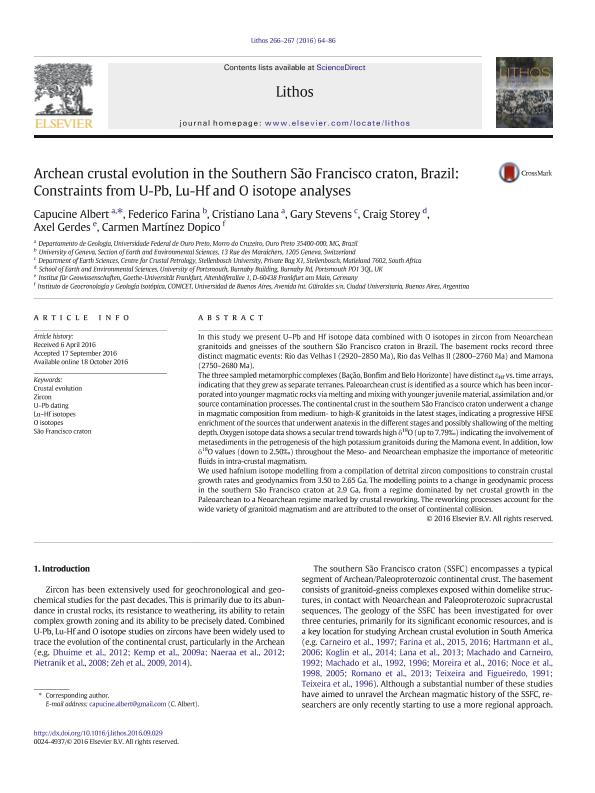Artículo
Archean crustal evolution in the Southern São Francisco craton, Brazil: constraints from U-Pb, Lu-Hf and O isotope analyses
Albert, Capucine; Farina, Federico; Lana, Cristiano; Stevens, Gary; Storey, Craig; Gerdes, Axel; Martínez Dopico, Carmen Irene

Fecha de publicación:
12/2016
Editorial:
Elsevier Science
Revista:
Lithos
ISSN:
0024-4937
Idioma:
Inglés
Tipo de recurso:
Artículo publicado
Clasificación temática:
Resumen
In this study we present U–Pb and Hf isotope data combined with O isotopes in zircon from Neoarchean granitoids and gneisses of the southern São Francisco craton in Brazil. The basement rocks record three distinct magmatic events: Rio das Velhas I (2920–2850 Ma), Rio das Velhas II (2800–2760 Ma) and Mamona (2750–2680 Ma). The three sampled metamorphic complexes (Bação, Bonfim and Belo Horizonte) have distinct εHf vs. time arrays, indicating that they grew as separate terranes. Paleoarchean crust is identified as a source which has been incorporated into younger magmatic rocks via melting and mixing with younger juvenile material, assimilation and/or source contamination processes. The continental crust in the southern São Francisco craton underwent a change in magmatic composition from medium- to high-K granitoids in the latest stages, indicating a progressive HFSE enrichment of the sources that underwent anatexis in the different stages and possibly shallowing of the melting depth. Oxygen isotope data shows a secular trend towards high δ18O (up to 7.79‰) indicating the involvement of metasediments in the petrogenesis of the high potassium granitoids during the Mamona event. In addition, low δ18O values (down to 2.50‰) throughout the Meso- and Neoarchean emphasize the importance of meteoritic fluids in intra-crustal magmatism. We used hafnium isotope modelling from a compilation of detrital zircon compositions to constrain crustal growth rates and geodynamics from 3.50 to 2.65 Ga. The modelling points to a change in geodynamic process in the southern São Francisco craton at 2.9 Ga, from a regime dominated by net crustal growth in the Paleoarchean to a Neoarchean regime marked by crustal reworking. The reworking processes account for the wide variety of granitoid magmatism and are attributed to the onset of continental collision.
Archivos asociados
Licencia
Identificadores
Colecciones
Articulos(INGEIS)
Articulos de INST.DE GEOCRONOLOGIA Y GEOLOGIA ISOTOPICA (I)
Articulos de INST.DE GEOCRONOLOGIA Y GEOLOGIA ISOTOPICA (I)
Citación
Albert, Capucine; Farina, Federico; Lana, Cristiano; Stevens, Gary; Storey, Craig; et al.; Archean crustal evolution in the Southern São Francisco craton, Brazil: constraints from U-Pb, Lu-Hf and O isotope analyses; Elsevier Science; Lithos; 266-267; 12-2016; 64-86
Compartir
Altmétricas



